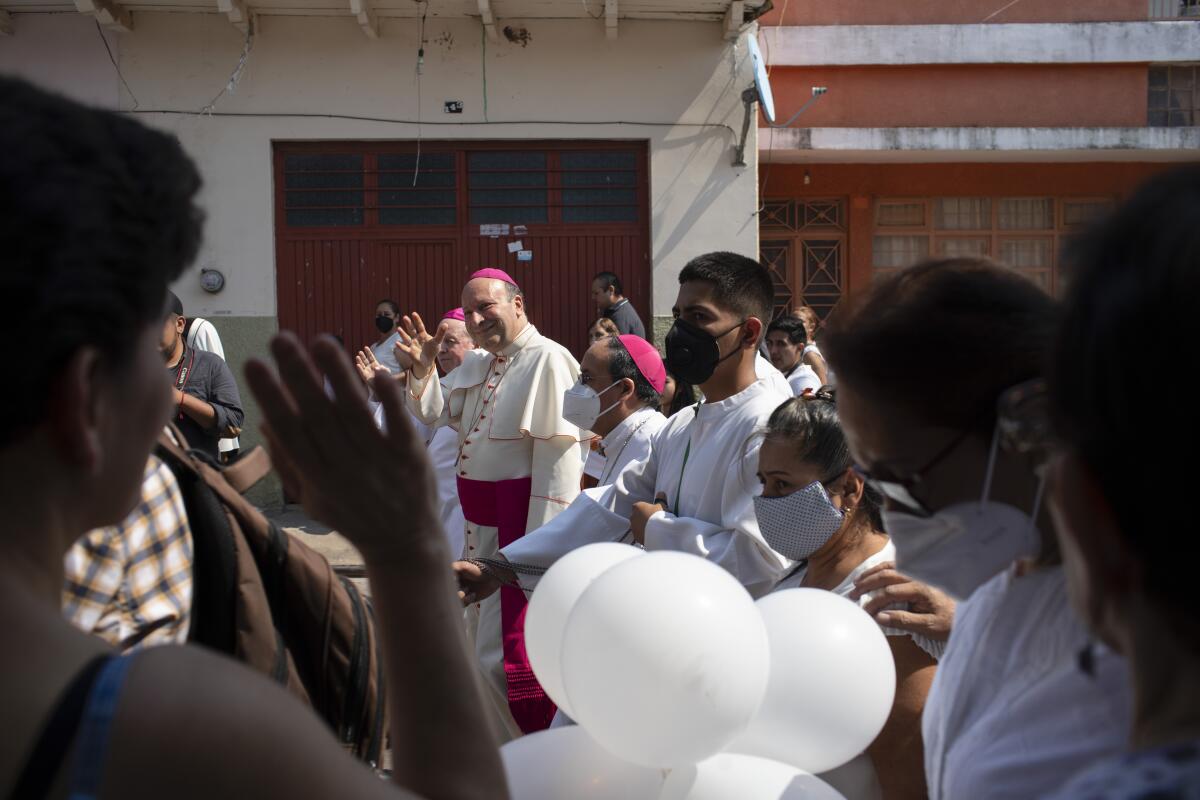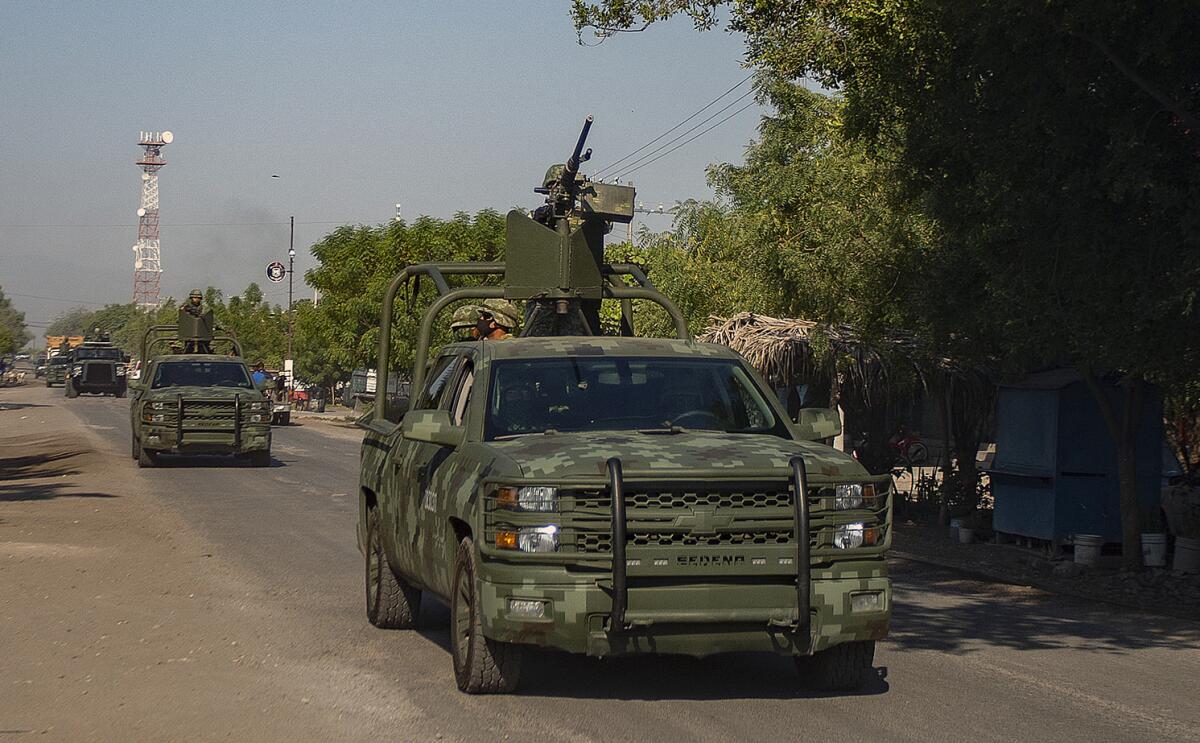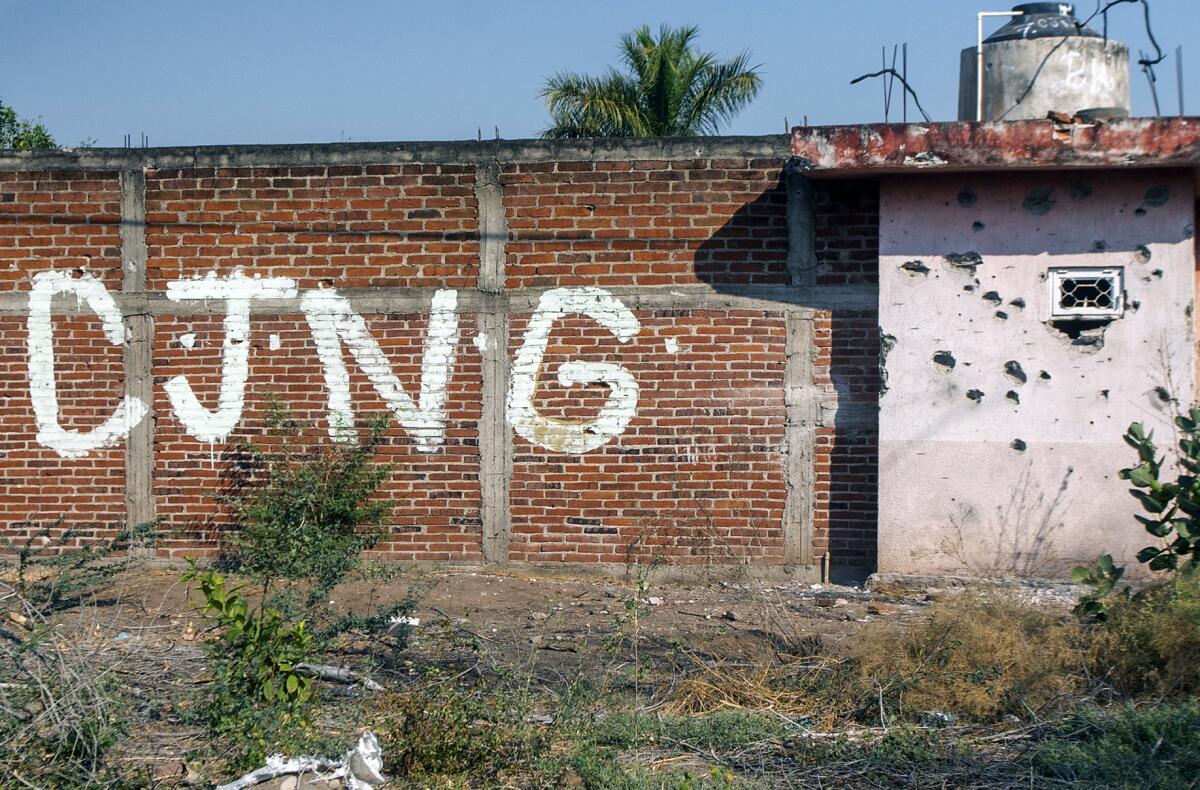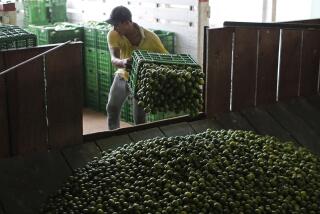âWe are trapped here.â A Mexican town isolated by cartel terror

APATZINGĂN, Mexico â The town of Aguililla, situated deep in one of Mexicoâs most lawless regions, made news this month when eight headless bodies were dumped there.
Three weeks later, it is at war. Hardly anybody enters or leaves â at least not without the permission of rival gangs that have blocked the roads.
In telephone interviews and in social media postings, trapped residents described a community living in terror of armed thugs who stroll the streets and shoot at one another. Some shops remain open, residents said, but the food supply is dwindling and there is no access to hospitals.
âIf the groups want to keep fighting among themselves, thatâs their problem,â said Father Gilberto Vergara, the parish priest. âBut this situation is suffocating us.â
The priest has publicly called on the gangs to let townsfolk travel to the nearest city â ApatzingĂĄn, a two-hour drive northeast â for food, medical care and gasoline, and to be able to sell their produce and cattle.

At the root of the mayhem is a struggle for control of a large segment of the narcotics trade in strife-ridden MichoacĂĄn state, and a government that has been powerless to prevent cartels from taking over large swaths of the nation.
In recent years, Aguililla, population 15,000, branched out from tomato farming, cattle ranching and marijuana cultivation to become a strategic hub for the manufacture of methamphetamine bound for the booming U.S. market.
Authorities say that dozens of illicit production facilities scattered in the nearby countryside process precursor chemicals smuggled from Asia into the Pacific port of LĂĄzaro CĂĄrdenas, 65 miles to the southeast.
Hundreds, if not thousands, of residents have fled the violence, some to the United States but many more to other parts of Mexico.
âI worked in Aguililla all my life. I have plots of tomatoes, corn, chile.⌠But we had to leave it all behind out of fear,â said Victor Arnoldo Aguaje, 68, who left last June with 14 relatives for Uruapan, the second-largest city in MichoacĂĄn.
âIn Aguililla, one lives with a constant fear that you may be killed or kidnapped at any moment,â he said.
The conflict demonstrates how gangs have infiltrated regional governance in much of Mexico. Authorities blame two cartels for the turmoil.
One, known as United Cartels, is a confederation of various mobs, including the MichoacĂĄn Family, the Knights Templars and Los Viagras, that U.S. prosecutors say is led by Adalberto Fructuoso ComparĂĄn RodrĂguez, 57, a former mayor of Aguililla.
He was arrested in Guatemala last month at U.S. behest for his suspected involvement
in a scheme to smuggle into Florida more than 1,100 pounds of Mexican methamphetamine hidden inside concrete tiles and dissolved in five-gallon buckets of house paint.

The competing group is the Jalisco New Generation Cartel, one of Mexicoâs largest syndicates, known for its expansionist bent and lurid social media displays of armored vehicles and military-grade weaponry.
Its leader, Nemesio Oseguera Cervantes â who is called âEl Menchoâ and once peddled heroin in bars in San Francisco â is wanted in both Mexico and the United States. He is reportedly a native of Aguililla.
âEl Mencho wants to control the area where he grew up,â said Mike Vigil, former head of international operations for the U.S. Drug Enforcement Administration. âItâs part of his big plan to move into strategic areas where he can control various criminal activities.â
Many in Aguililla are calling on the Mexican government to intervene.
âOf course we want the military to come and fight the criminals,â Maribel LĂłpez, 53, a nurse, said by telephone. âIs it too much to ask that they at least open up the roads to ApatzingĂĄn?â
Her diabetic aunt died a few weeks ago because the roadblocks prevented relatives from getting her to the hospital, LĂłpez said.
There is a widespread belief in Aguililla that security services and the military collaborate with the cartels. Video on social media showed townsfolk jeering Mexican national guard units as they retreated from the town.
A military base of 200 soldiers is situated in Aguililla, its troops resupplied by helicopter, but forces have avoided direct conflict with the warring gangsters.
A Pentagon official recently estimated that cartels control about one-third of Mexican territory. President Andres Manuel LĂłpez Obrador disputed that figure at a recent news conference but declined to provide his own.
For more than a decade, Mexico waged a âwar on drugsâ that led to tens of thousands of deaths but did little to weaken organized crime â an approach that LĂłpez Obrador abandoned in favor of avoiding direct conflict while providing economic opportunities for poor youth to keep them out of gangs
But the strife in Aguililla is severely testing his strategy in the run-up to the national midterm elections in June.
âThe approach of the current administration to insecurity, to the whole armed conflict, has been silence,â said Falko Ernst, a senior analyst in Mexico with the International Crisis Group, a nonprofit that researches conflict. âTheir political calculation is that itâs better not to talk about it.â
LĂłpez Obrador has defended his decision to hold back from a military assault on Aguililla.
âIf we take towns and use force, invade with police, with soldiers, well that will lead to nothing good,â LĂłpez Obrador told reporters this month. âWe have to call to everyone for serenity, for tranquility, to look for peace. No to violence.â
In 2019, 14 state police officers were killed in an apparent cartel ambush in Aguililla. This past week state police dispatched to Aguililla were attacked by at least one cartel drone armed with explosives. Authorities said two officers suffered minor injuries.
The president backed dialogue in hopes of resolving the situation there.
But Silvano Aureoles, the governor of MichoacĂĄn, said that a solution was elusive without the deployment of federal forces.
âOne can dialogue with communities in conflict, with social groups, but to dialogue with criminals is another matter,âAureoles told Mexicoâs Milenio news outlet.
Not that his own efforts have fared any better.
The governor flew into Aguililla in a military helicopter last week in a much-hyped display to show that security had improved.
Accompanied by heavily armed body-guards, he was met by several protesters in the townâs central square who hoisted handwritten signs demanding that authorities restore the peace and open the roads. âI want to live free in my pueblo,â read one placard.
âThe people donât believe in the government â we have no security or tranquility,â said Fernando Padilla, 43, a teacher in Aguililla, who brought his 10-year-old son to the protest.
âThe government comes here to make a âshow,â says the situation is tranquil, but itâs not true. ⌠We are at the mercy of the criminals, we are trapped here. This is not a life.â
Video from the scene showed the governor approaching the protesters and shoving Padilla as security guards grabbed two of the protestersâ signs.
After the shove went viral on social media, the governor asserted on Facebook that he had been confronted by hostile cartel âlookouts.â
Padilla, who has taught for 20 years in Aguililla, denied any links to drug traffickers.
The governorâs characterization of the protesters as mob lookouts, he said, had put their lives in further danger. He said his salary was suspended after the incident â a move he viewed as retaliation for his protest â but was later restored when he complained to local press.
Ominously, Padilla said, armed men have been passing by his house.
âOne doesnât know anymore if this is normal or whether these delinquents are coming for me,â he said. âThe people of Aguililla are stuck in a living hell, trapped and governed by criminality.â
SĂĄnchez is a special correspondent. Special correspondent Liliana Nieto del RĂo contributed to this report.
More to Read
Sign up for Essential California
The most important California stories and recommendations in your inbox every morning.
You may occasionally receive promotional content from the Los Angeles Times.










